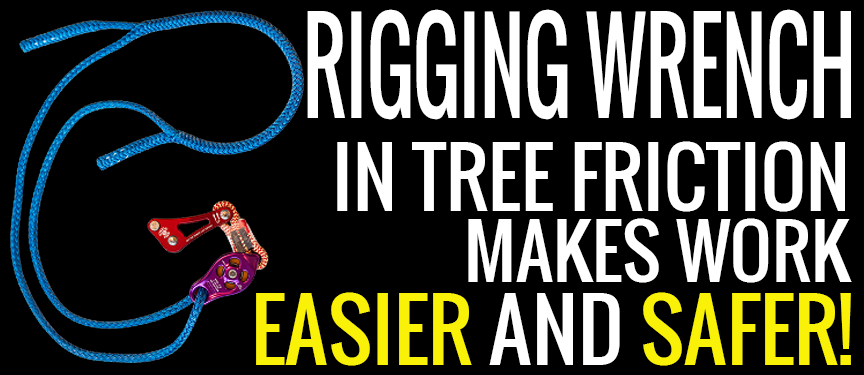
Remove Limbs Easier with the Rigging Wrench
Have you ever been up in a tree and needed to lift some limbs, maybe to clear a roof or overhand, but also needed to immediately have some sort of friction on the rope because the pieces were too heavy for your ground guy to hold them? Many times when I was doing line clearance, we would find ourselves in these situations where we were lifting limbs off of or over power lines, but also needed at immediate friction to help us lower the limbs. We tried to have someone lifting while the other was taking up slack with the Port a Wrap, but that never really kept all the slack out of the system, and if the piece came off too early, there were way too many hands near the Port a Wrap to let something run at the correct time. So, as always, Kevin Bingham, who invented the Rope Wrench and Rope Runner, came up with a super cool use for the already popular Rope Wrench: the Rigging Wrench!
Great for Most Light Weight Applications
The Rigging Wrench is a Rope Wrench attached to a DMM Pinto Rig pulley by means of a short tether; this is all connected to a 3/8' Tenex Loopie sling. The sling is adjustable from 3' to 8' for a pretty wide range. The Rope Wrench is rated to fit 1/2' rigging line and the Pinto Rig has an MBS of over 10,000lbs. So the Rigging Wrench is a great tool for most of your light to mid weight rigging applications.
The cool thing about the Rigging Wrench is that when a rope is loaded through the Pinto and into the Rope Wrench correctly, the rope can be pulled up friction-free, but as soon a limb or log puts weight onto the rope, the wrench flips down and creates a bend in the rope that creates friction just like a Port a Wrap does! This is awesome because it allows slack to be taken up and limbs to be lifted and then immediately have friction applied to them to make lowering easier.
Reduce the Load Weight
From our previous blog post discussing loads in rigging, we know that there is roughly 2x the amount of downward force on our rigging point when using a block and Port a Wrap. That means that the 5oo lb limb that you are lowering will create 1,000 lbs of force on your rigging point! The reason behind this is simple: if the log weighs 500 lbs and passes over a block at the top of the tree, you will also need 500 lbs on the other side of that rope to hold it. This means that you will have 500 lbs + 500 lbs giving you 1,000 lbs of downward force at your rigging point.
The neat thing about the Rigging Wrench is that it creates friction at your rigging point. This means that you can have a 500 lb log on the one side of your rope and once the Rigging Wrench is engaged it will help hold some of the weight of that 500 lb log. Therefore, you won't need to hold the full 500 lbs on the opposite side of the rope. This means that the amount of downward force on the rigging point will actually be less because 500 lb (log) + 200 lbs (reduction in weight due to friction) = 700 lbs of downward force on your rigging point! This could make rigging in a dead tree quite a bit easier and less nerve racking than with a typical style rigging setup.
Proper Set Up is Paramount
A couple things to keep in mind when using the Rigging Wrench is to be sure the rope is loaded correctly through the Rope Wrench. I find that the best way to do this is to install your rigging line through the Pinto Rig. Next, take the pulley side of the Rope Wrench and put it right against the pulley section of the Pinto Rig. Then just take the slick pin out of the Rope Wrench and slip your rope into it. This will make sure that when the Rope Wrench engages, it will actually create a bend in the rope instead of just letting the rope fall through.
Note of caution: You can get into a world of trouble if you load the Rope Wrench backwards because it won't create any friction and can lead to pieces plummeting to the ground. ALWAYS be sure the rope is through the Rope Wrench correctly!
Another thing to consider is that you can overload the Rigging Wrench. I would recommend using this on pieces that are 500 lbs or less. Once you get above this weight, it becomes pretty hard for the friction created by the Wrench to make it possible to comfortably lower loads. You could add in additional friction at the base of the tree, but this will create higher forces at the rigging point, much like a typical rigging setup. Also, rigging anything bigger than 500 lbs will take you over the WLL (working load limit) of the configured pieces. Be sure to stay within the limits of your gear and it will keep your day safe!
The Rigging Wrench is a great tool for light rigging scenarios where tons of lifting and lowering are needed. This tool works especially well when you want to quickly lift and lower instead of using something like a GRCS for large scale lifting jobs. Just be sure to know all the tendencies of the device before using it in a working scenario. Come into the shop and check one out! Do you use a Rigging Wrench now? Do you love using it? We would love to hear your thoughts in the comment section below!

Leave a comment